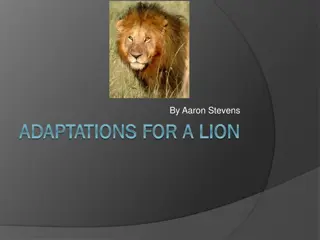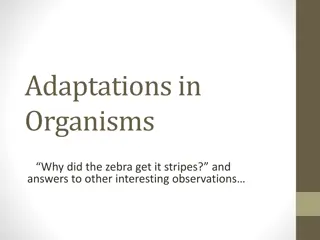Evolution of Film Adaptations: From Silent Cinema to Modern Innovations
The moving picture industry emerged in the 1890s, paving the way for adaptations of literary works in the early 1900s. With the advent of sound, a new era of adaptations began, leading to experiments and innovations in modern filmmaking. Adaptation is a process of adjusting and presenting a work in
8 views • 23 slides
Birds: Adaptations of Beaks and Feet for Survival
Explore the fascinating world of bird adaptations through the modification of beaks and feet. From tearing and piercing beaks to fruit-eating beaks, mud-probing beaks, fish-catching beaks, and wood chiselling beaks, discover how different bird species have evolved unique features to thrive in their
5 views • 29 slides
Exploring Seed Plant Diversity and Adaptations
Delve into the realm of seed plants, uncovering their unique adaptations for reproduction, their phylogeny with gymnosperms and angiosperms, and the diversity within gymnosperms such as conifers, cycads, gingkophytes, and gnetophytes. Discover the evolutionary success of seed plants through their wa
5 views • 23 slides
Alimentary Canal and Feeding Adaptations in Fishes by Dr. Sunitha A. Philip
The presentation discusses the alimentary canal and feeding adaptations in fishes, covering topics like the different regions of the gut, mouth types in fish, adaptation of teeth for specific diets, and the roles of the buccal cavity, pharynx, and gill rakers. It further explores how gill rakers var
0 views • 24 slides
Adaptations in Helminth Parasites: Structural and Morphological Changes
Helminth parasites exhibit adaptations for successful living within hosts, involving structural modifications such as degeneration and new organ formation. Parasitism has evolved over time, leading to a dependent relationship between parasites and hosts. The adaptations in locomotory, digestive, and
1 views • 19 slides
Desert Adaptations: Animals and Habitat Survival
Habitats play a crucial role in the survival of animals, especially in harsh environments like deserts. Explore the unique adaptations of animals like camels and learn how they are perfectly suited to thrive in hot, arid conditions. Understanding these adaptations is key to appreciating the diversit
0 views • 16 slides
Adaptations of Cursorial Animals: Cheetah, Horse, and Musk Deer
Explore the cursorial adaptations of three distinct animals - the cheetah with its incredible speed, the horse designed for swift running, and the musk deer adapted for elusive movements. Learn about their habitats, unique characteristics, and specialized adaptations for survival in their environmen
0 views • 12 slides
Comprehensive Guide on Dog Care and Management
Learn about housing, feeding, and dimensions of kennels for dogs, along with tips on appropriate feeding that plays a crucial role in keeping dogs healthy and fit. Dr. R.R. K. Sinha provides valuable insights on the care and management of dogs, emphasizing the importance of suitable housing, feeding
0 views • 42 slides
Essential Guidelines for Feeding Poultry for Optimal Production
Feeding poultry is a crucial aspect of poultry production, accounting for a significant portion of total expenses. Quality feed and proper feeding methods are key to maximizing efficiency. Understanding the nutritional needs of poultry, including water, carbohydrates, proteins, fats, vitamins, and m
1 views • 18 slides
Understanding Feeding Standards and Their Objectives in Livestock Nutrition
Feeding standards provide tables indicating nutrient quantities necessary for livestock based on various physiological functions like growth, maintenance, lactation, and more. Objectives include guiding farmers in selecting balanced rations and classifying functions for individual animal needs. Glos
0 views • 13 slides
Amazing Adaptations of the Painted Turtle
Discover the incredible adaptations of the painted turtle, also known as Chrysemys picta. Surviving freezing ponds, hibernating without oxygen, and using its colorful shell for camouflage are just a few ways this unique turtle thrives in its environment. Learn how it climbs with its clawed feet and
0 views • 8 slides
Understanding Fish Mouth Positions and Feeding Habits
The position of a fish's mouth reveals valuable information about its feeding habits, behavior, and lifestyle. Fish mouths can be categorized as superior (upward-facing), terminal (forward-facing), or inferior (downward-facing), each adapted for specific feeding strategies. Superior mouths are ideal
5 views • 10 slides
Infant and Young Child Feeding in Emergencies: Operational Guidelines
Infant and Young Child Feeding in Emergencies (IYCF-E) focuses on protecting and supporting safe feeding practices for infants and young children during all types of emergencies to reduce mortality and morbidity risks. Key actions include developing policies, training staff, coordinating operations,
4 views • 10 slides
Understanding Feeding Standards in Ruminant Nutrition
Feeding standards play a crucial role in determining the nutritional needs of animals for optimal health and productivity. They consider factors like productivity, product composition, and physiological conditions, guiding effective nutritional management. Despite their usefulness, feeding standards
0 views • 8 slides
Fossorial Specimens: Mole and Caecilian Adaptations
Fossorial specimens, including the mole and caecilian, are uniquely adapted for subterranean burrowing. The mole, commonly known for its wedge-shaped head and reduced eyes, lives in tunnels and feeds on small worms and insects. On the other hand, the limbless caecilian, resembling a worm, thrives in
1 views • 25 slides
Sheep and Goat Clinic: Feeding, Exercising, and Show Preparation Tips
Topics covered in the Sheep and Goat Clinic include feeding strategies (last 90 days), the importance of balancing fat levels, exercising routines leading up to show day, and final points on feeding and fat management. The images provide valuable insights on feeding athletes, understanding fat level
0 views • 20 slides
Integrating Nutrition Assessment and Counselling: Complementary Feeding Practices
This training course focuses on educating facility-based health providers on complementary feeding practices, emphasizing the importance of introducing solid foods along with breastfeeding at 6 months. The session covers topics like nutrition gaps in breast milk, optimal feeding principles, and util
0 views • 48 slides
Amazing Adaptations of Lions in the Wild
Lions have incredible adaptations that aid in their survival and hunting strategies. Their loose body skin, mane, eyes, muscled forelimbs, rough tongue, color, and more play crucial roles in their ability to thrive in their environment. Explore these fascinating adaptations through images and descri
0 views • 8 slides
Guidance for Complementary Feeding in Infants
After 6 months of age, breastfed infants may struggle to meet their nutrient needs from milk alone, necessitating the introduction of complementary foods. Implementing guiding principles can help ensure optimal nutrition and growth, including exclusive breastfeeding for the first 6 months, practicin
0 views • 18 slides
Understanding Dugongs: Marine Chordates of the Ocean
Dugongs, known as sea cows, are fascinating marine chordates with a broad but fragmented range in tropical waters. They exhibit social behaviors, communicate through echoing sounds, and are herbivorous grazers feeding on seagrasses. Breeding season rituals involve courtship behaviors like vocalizati
0 views • 7 slides
Understanding Habitats, Adaptations, and Food Chains in Ecosystems
Explore the concepts of habitats, adaptations, and food chains in ecosystems. Learn how different environments support diverse organisms, how adaptations aid survival, the impact of competition for resources, and the flow of matter and energy through food chains. Discover the interdependence of plan
0 views • 51 slides
Assisting with Oral Feeding, Dysphagia Management, and Enteral Tube Feeding in Healthcare
This content covers essential aspects of assisting with oral feeding for individuals at risk for aspiration, managing dysphagia with specific recommendations and diet progression, and enteral tube feeding procedures and complications. It emphasizes safety, dignity, and independence in feeding practi
3 views • 12 slides
Assisting with Enteral Tube Feeding and Dysphagia Management
This content covers essential information on assisting with oral feeding for patients at risk of aspiration, managing dysphagia, diet progression, and enteral tube feeding procedures. It emphasizes safety, independence, and dignity in feeding practices. The content includes tips for preventing aspir
0 views • 12 slides
Integrating Nutrition Assessment and Counseling for Child Feeding During Illness
This training session focuses on the importance of feeding children during illness and recovery, discussing feeding practices and options in difficult circumstances. Participants will learn strategies to encourage children to eat during challenging times, emphasizing the goal of continuing feeding r
0 views • 32 slides
Evolution Unit Test Review - Adaptations and Benefits Matching
In this review, you will match various adaptations to the benefits they provide in the context of evolution. From heavy fur of the Snow Leopard to wing-like shape of maple seeds, explore how different adaptations help organisms cope with climate, obtain food and water, attract mates, escape predator
0 views • 21 slides
Ration Formulation and Feeding Practices for Dairy Cattle and Buffaloes
This informative article discusses the importance of colostrum feeding, milk feeding to calves, and milk feeding schedules for dairy cattle and buffaloes during various phases. It emphasizes the significance of timely colostrum intake for immunity development and the proper feeding of whole milk or
0 views • 20 slides
Evolutionary Adaptations in Animals and Their Mouthparts
Environmental conditions have influenced the evolution of animals, leading to adaptations that allow them to survive and thrive. One crucial aspect is the relationship between animals, their environment, and food sources, shaping physical traits like mouthparts for efficient feeding. Explore how dif
0 views • 9 slides
Amazing Adaptations of Giraffes
Giraffes have unique adaptations that help them thrive in their environment. With their long necks, tough hooves, and specialized features like long tongues and tough lips, giraffes can reach high branches, protect themselves from harm, and access water efficiently. These adaptations, such as their
0 views • 10 slides
Insight Into the Adaptations and Habits of Aquatic Freshwater Eels
The Anguillidae family includes freshwater eels with snake-like bodies, dwelling in diverse habitats. Their catadromous nature involves migrating to the ocean to breed. Freshwater eels serve dual roles as predator and prey, displaying unique feeding behaviors. Their body structures feature elongated
0 views • 15 slides
Exploring the Fascinating Adaptations of the Portuguese Man o' War
Discover the remarkable aquatic specimen, the Portuguese man o' war, found in tropical waters. Learn about its unique adaptations, habitat, body structure, and fascinating commensalism and symbiosis with fish like Nomeus gronovii. Explore how strong winds can drive these creatures ashore and how the
0 views • 15 slides
Adaptations of Xerophytes in Different Habitats
Xerophytes, plants adapted to dry habitats, possess specific adaptations to prevent excessive water loss such as sunken stomata, presence of hairs, thick waxy cuticle, and rolled leaves. These adaptations help xerophytes thrive in arid conditions, maintaining humid air around stomata and maximizing
0 views • 13 slides
Tiger Adaptations and Characteristics
Tigers possess unique adaptations such as their striped coat for camouflage, sensitive hearing capable of picking up infrasound, retinas that reflect more light, sharp claws for hunting and climbing, large teeth for catching prey, a long tail for balance while running, and a powerful roar when threa
0 views • 9 slides
Animal Adaptations in Different Habitats
Understanding animal adaptations in various habitats is crucial for appreciating how different species have evolved to thrive in specific environmental conditions. This presentation explores different habitats like woodlands, sand dunes, and rock pools, highlighting the unique features and adaptatio
0 views • 11 slides
Understanding Platyhelminthes: Characteristics and Adaptations
Platyhelminthes, also known as flatworms, exhibit a dorsoventrally flattened body with bilateral symmetry. They can be endoparasites or free-living organisms, with some displaying unique adaptations for attachment and survival. These acoelomate organisms lack a complete digestive system, excreting w
0 views • 6 slides
Exploring Crayfish Anatomy and Adaptations in Biology Lab
Explore the fascinating world of crayfish anatomy and adaptations through hands-on dissection activities in a biology lab setting. Identify phylum, examine external anatomy, study compound eyes, and delve into the function-form relationship within the phylum. Engage in interactive tasks like drawing
0 views • 22 slides
Xerophytes: Adaptations to Thrive in Dry Environments
Xerophytes are plants that adapt to dry habitats by developing specialized structural and physiological features. These adaptations include deep root systems, succulent tissues for water storage, reduced leaf size with protective waxy coatings, and shortened life cycles for favorable conditions. Mor
0 views • 8 slides
Understanding Adaptations in Organisms: from Zebra Stripes to Diabetes
Adaptations in organisms play a crucial role in survival within their ecological niche. This article explores the reasons behind zebra stripes, the impact of traits that may not seem advantageous, the mechanisms of diabetes, and how environmental conditions can influence genetic traits. By delving i
0 views • 20 slides
Aquatic Adaptations in Marine Life
This informative content discusses the primary and secondary aquatic adaptations in marine animals such as fish, whales, turtles, and ducks. It covers various adaptations like streamlined bodies, presence of swim bladders, flippers for navigation, and webbed feet for swimming. Each adaptation is vit
1 views • 14 slides
Understanding Nutrition in Animals: Types and Process
Nutrition in animals is vital for their survival, with various categories like herbivores, carnivores, and omnivores. Different modes of nutrition include filter feeding, deposit feeding, bulk feeding, fluid feeding, and suction feeding. The process of nutrition involves ingestion, digestion, absorp
0 views • 14 slides
Systematic Assessment of Adaptations in Health System Interventions
This presentation at the 4th Biennial Conference for the Society for Implementation Research Collaboration discusses the systematic multi-method assessment of adaptations in five health system interventions. It covers the definitions of adaptations, balancing fidelity and adaptation, and lessons lea
0 views • 23 slides







































